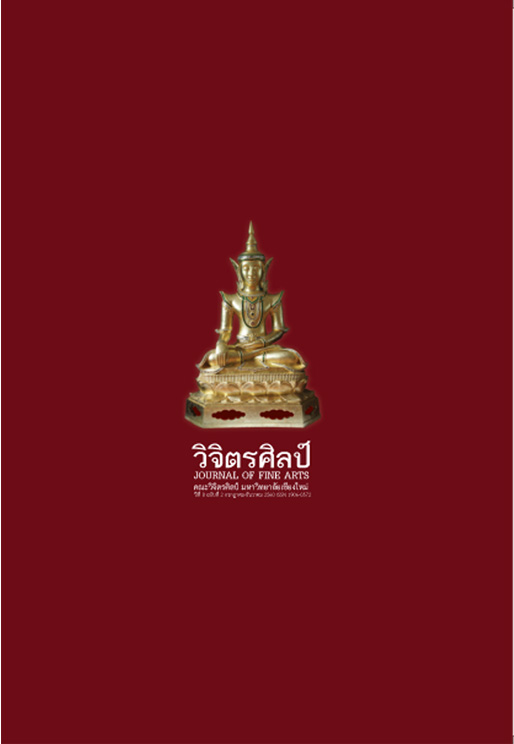การรับรู้เรื่องราวประวัติศาสตร์ท้องถิ่น “พระนางจามเทวี” สู่แนวทางการพัฒนาในจังหวัดลำพูน
Main Article Content
Abstract
การรับรู้ประวัติพระนางจามเทวีตามกระแสการเปลี่ยนแปลงในยุคโลกาภิวัตน์ กลายเป็นประวัติศาสตร์ท้องถิ่นที่มีพลังขับเคลื่อนในการพัฒนาจังหวัดลำพูนในปัจจุบัน โดยการเผยแพร่สื่อที่นำมาสู่การรับรู้แบ่งได้ 2 ประเภท ที่นำไปสู่การพัฒนาเมืองลำพูนตามแนวทางต่างๆ คือ
การรับรู้จากเอกสาร ตำนาน และเรื่องเล่า จากการสัมภาษณ์ผู้สูงอายุที่มีอายุอยู่ในช่วง 60-100 ปี ในจังหวัดลำพูน พบว่าการรับรู้เรื่องราวของพระนางจามเทวีจากคำบอกเล่าที่กล่าวว่าสถานที่กำเนิดพระนางอยู่ที่บ้านหนองดู่โดยมีตำนานท้องถิ่นสนับสนุนเรื่องเล่านี้ ทำให้ตั้งแต่ พ.ศ.2547 เป็นต้นมาเกิดการพัฒนาทางวิชาการเพื่อหาข้อมูลรองรับโครงการผลักดันเมืองลำพูนสู่มรดกโลก การค้นคว้าประวัติศาสตร์ท้องถิ่น รวมทั้งการขุดแต่งแหล่งโบราณสถานบ้านหนองดู่ และบ้านบ่อคาว เป็นการเพิ่มคุณค่าแก่มรดกทางศิลปวัฒนธรรมในเมืองลำพูน
การรับรู้จากสื่อประกอบการเล่าเรื่อง ที่สร้างขึ้นเพื่อเป็นสัญลักษณ์ถ่ายทอดเรื่องราวของพระนางจามเทวี เช่น ภาพจิตรกรรมฝาผนัง รูปปั้น ภาพเหมือน วัตถุมงคล ในการเชื่อมโยงสถานที่เกี่ยวข้องกับประวัติพระนางจามเทวี ให้เป็นพื้นที่ประกอบพิธีกรรมบวงสรวง จัดกิจกรรมการแสดงต่างๆ ในจังหวัดลำพูน เป็นการผลิตซ้ำสัญลักษณ์ และเรื่องราวของพระนางจามเทวี เพื่อสร้างอัตลักษณ์ของจังหวัดลำพูน ในการระดมทุนและกำลังคนเพื่อสนับสนุนการจัดงานประเพณี พิธีกรรม การส่งเสริมศิลปวัฒนธรรม และกิจกรรมประจำปีในระดับจังหวัด
The Perception of Local History: Queen Camadevi and Developments in Lamphun Province
Public perceptions of Queen Camadevi have changed in accordance with the currents of globalization, and today, historical narratives of Queen Camadevi represent a local history with dynamic force for mobilizing present-day Lamphun development schemes. As this paper will illustrate, there are two broad narratives relating to Queen Camadevi which have been linked to Lamphun’s city development, as follows.
The first narrative is derived from Tamnān or a Buddhist chronicle, as well as oral traditions gathered from interviewing the elderly aged 60-100 years in Lamphun Province. These findings illustrated a narrative of Queen Camadevi from oral traditions locating her birthplace at Ban Nong Doo, for which there is a local chronicle to support this folktale. Since 2547 B.E., this has given rise to academic interest and research in order to find some data to support the project for supporting the old city of Lamphun to be a a World Heritage site. The study of local history as well as the excavation of archeological sites at Ban Nong Doo and Ban Boh Kao are a valuable contribution to art and cultural heritage in Lamphun.
Another narrative derives from visual and mass media programs created as symbols for transmitting the accounts of Queen Camadevi, such as the murals, the sculptures, the portraits, and auspicious objects that linking together the places related to the history of Queen Camadevi in order to use as sites for performing sacrificial rituals with accompanying cultural stage shows in Lamphun Province. These reenactments were intended to create an identity of Muang Lamphun and to generate funds as well as volunteer participation to support the organizing of the aforesaid festival for the promotion of arts and culture, and annual traditions at the provincial level.

